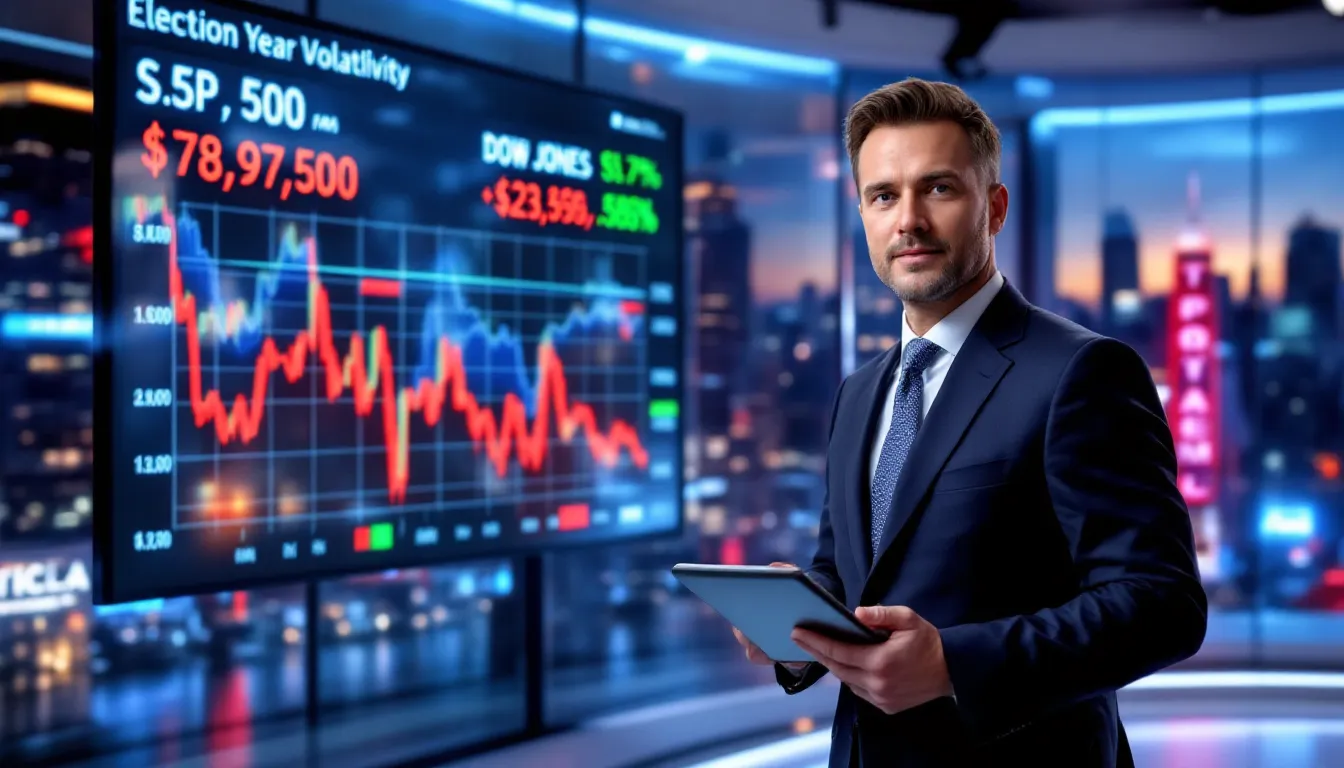Table of Contents
ToggleEvery four years, the stock market turns into a wild rollercoaster ride, and it’s not just because of the cotton candy and funnel cakes. Presidential election years bring a unique blend of uncertainty and opportunity that can leave even seasoned investors scratching their heads. With candidates making promises that could shake up the economy, it’s no wonder the market reacts like a toddler who just lost their favorite toy.
Overview of the Stock Market During Presidential Election Years
Stock market performance tends to fluctuate significantly during presidential election years. Investors often react to the unpredictability of candidate policies and their potential impact on the economy. Historical data shows that stock indices like the S&P 500 can experience notable volatility as Election Day approaches.
Market performance often correlates with political party affiliation. For instance, studies reveal that stock markets typically perform better under Democratic administrations compared to Republican ones, although exceptions exist. The month leading up to elections also sees increased trading volumes as traders anticipate shifts based on polling data.
Uncertainty drives fluctuations, as shifts in political climate can influence economic policies. For example, major changes in fiscal policy could emerge depending on the winning candidate’s platform. Investors frequently adjust their portfolios in response to anticipated shifts, contributing to market volatility.
The immediate post-election phase often sees a surge in market activity. Positive sentiment surrounding the legitimacy of the election and new policies can bolster investor confidence. Conversely, contentious elections can lead to uncertainty, fostering cautious investor behavior and potential market downturns.
Ultimately, understanding the nuances of market behavior during these years provides insight for investors. Observing historical trends enables them to make informed decisions and adapt strategies accordingly. Monitoring economic indicators alongside political events can yield valuable information as investors navigate the stock market landscape.
Historical Trends
Stock market behavior during presidential election years reveals intriguing patterns. Historical data indicates notable fluctuations as candidates vie for public support and unveil their economic policies.
Analysis of Past Election Years
Examining past election years highlights the stock market’s tendency to react to political events. For example, during the 1940 election, the S&P 500 gained 19 percent, driven by a favorable economic climate under a Democratic administration. In contrast, the 2008 election saw the market decline by 38 percent, attributed to the subprime mortgage crisis and general economic instability. The 2016 election also showcased volatility as the market fluctuated in response to unexpected polling results, ultimately recovering swiftly post-election. Investors often adjust strategies based on their perceptions of candidates’ policies and party affiliations.
Impact of Major Events
Major events significantly impact stock market trends during election cycles. Political debates, Supreme Court decisions, and international incidents contribute to market fluctuations. For instance, in 2000, the contentious Florida recount created uncertainty, leading to increased volatility in the markets. The pandemic in 2020 resulted in unique market behaviors, with massive stimulus measures introduced influencing investor sentiment. Economic reports and unemployment data also play pivotal roles, directly affecting stock prices. Political developments continuously shape investor attitudes, ultimately influencing trading volumes and market performance throughout election years.
Factors Influencing Stock Market Performance
Factors affecting stock market performance during presidential election years are complex and multifaceted. Economic indicators and political climate play significant roles in shaping investor sentiment and market fluctuations.
Economic Indicators
Economic indicators, such as Gross Domestic Product (GDP) growth, unemployment rates, and inflation data, significantly influence stock market behavior. Strong GDP growth typically reflects a healthy economy, often resulting in increased investor confidence and higher stock prices. Conversely, high unemployment signals economic challenges, leading to cautious trading. Inflation metrics can also dictate central bank policies. Tight monetary policy may dampen market enthusiasm, while low inflation can support stock increases. Market participants keep a close eye on these reports, which can alter trading volumes during election years. For example, employment numbers reported before an election can sway investor decisions dramatically.
Political Climate
Political climate plays a crucial role in dictating stock market performance during election years. Candidates’ proposed policies and platforms frequently generate uncertainty among investors. Changes in leadership bring potential shifts in economic strategies, creating uneven market expectations. The perception of which political party may ascend influences trading behaviors. For instance, historical data shows markets tend to thrive under Democratic presidencies, although circumstances like economic crises can disrupt this trend. Political debates and key announcements can also heighten volatility, prompting immediate reactions in stock prices. Investors must remain attentive to these developments as they can directly impact market directions amidst the electoral process.
Investor Behavior
Investor behavior shifts notably during presidential election years, influenced by the political climate and economic indicators. Uncertainty drives many decisions, as market participants react to candidate policies and potential changes in governance.
Trends in Investor Sentiment
Investor sentiment often fluctuates with polling data and election news. Positive polling for a favored candidate generally boosts confidence, leading to increased buying activity. Conversely, negative headlines or unexpected developments can trigger caution, prompting many investors to sell. Historical data shows that the S&P 500 frequently rises during Democratic administrations due to optimistic policies, while Republican leadership might induce mixed reactions, depending on economic conditions. Market reactions hinge not just on party affiliation, but also on overall economic health and investors’ perceptions of future growth, illustrating the complex interplay of sentiment and market dynamics.
Patterns in Trading Volume
Trading volume typically spikes in the weeks leading up to an election. Increased activity indicates heightened investor interest and engagement with the market. The month preceding major elections often sees trading volumes surpassing average levels by significant margins, as traders react to new information, including candidate debates and poll results. Historical patterns reveal significant trading shifts during pivotal election years, like the notable volumes observed in 2008 amid the financial crisis and the 2020 election influenced by the pandemic. Market volatility increases during these periods, as traders adjust strategies based on evolving political scenarios, illustrating a direct response to electoral developments.
Case Studies of Notable Elections
Analyzing specific presidential elections reveals intriguing stock market trends during these pivotal moments.
2008 Presidential Election
The 2008 election marked a significant downturn, with the S&P 500 experiencing a 38 percent decline amid the global financial crisis. Investor panic intensified as the subprime mortgage crisis unfolded, forcing many to reassess portfolio strategies. Economic uncertainty shaped trading volumes, which surged as participants reacted to bank bailouts and falling employment rates. The month leading up to Election Day saw wild fluctuations, with panic selling dominating the market. Despite the gloomy economic backdrop, post-election, the market rebounded sharply as Barack Obama’s victory instilled renewed investor confidence in recovery measures.
2016 Presidential Election
In the 2016 election, market reactions reflected the unexpected nature of the results. Following Donald Trump’s victory, the initial response involved considerable volatility. The S&P 500 experienced immediate sell-offs driven by uncertainty surrounding future policies. Market sentiment shifted quickly, however, as optimism about tax reforms and deregulation emerged. Trading volumes increased significantly, reflecting heightened engagement during this election cycle. By the end of 2016, the market rallied, showcasing a strong recovery, fueled by promises of economic growth and deregulation initiatives. Investors adapted, responding to the new political landscape and its potential implications for the economy.
Navigating the stock market during presidential election years presents unique challenges and opportunities for investors. The interplay of political uncertainty and economic indicators creates a dynamic environment that can lead to significant market fluctuations. Historical trends reveal that while markets may react negatively to uncertainty, they often recover swiftly post-election, influenced by renewed investor confidence.
Understanding these patterns allows investors to make informed decisions. By staying attuned to polling data economic reports and major political events, they can better anticipate market movements. Ultimately the ability to adapt to the evolving landscape during election years can significantly impact investment outcomes.




